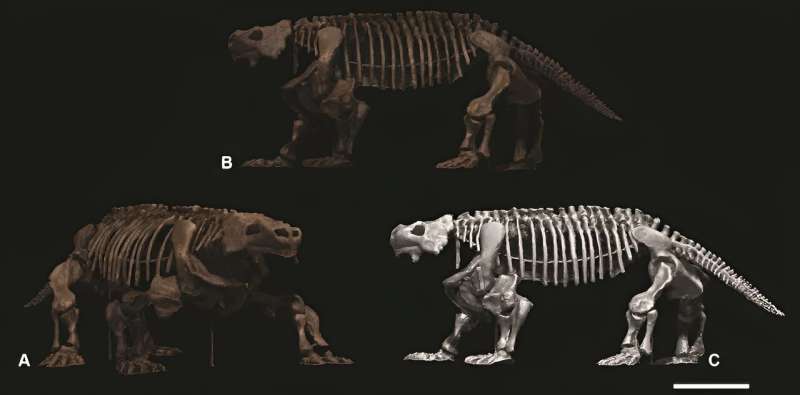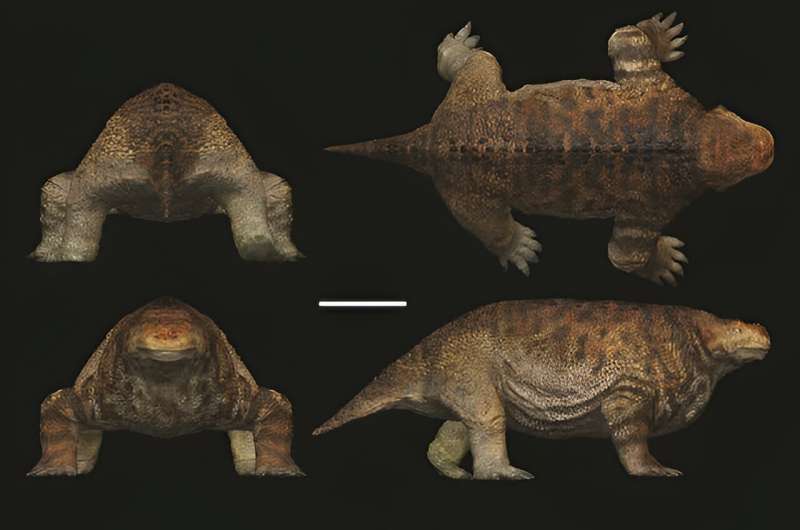This article has been reviewed according to Science X's editorial process and policies. Editors have highlighted the following attributes while ensuring the content's credibility:
fact-checked
trusted source
written by researcher(s)
proofread
Meet the gigantic extinct reptile that weighed as much as an adult black rhino

Around 262 million years ago, during the middle Permian Period, a new family of reptiles emerged. Pareiasaurs—meaning "cheek lizards," a reference to the flat flanges of bone that make up their cheeks—had skulls covered in bony growths and bumps, and bony plates on their bodies.
They were among the first large terrestrial animals to evolve and did so rapidly, quickly becoming some of the most abundant plant-eating animals worldwide. At least 21 separate species evolved before all pareiasaurs were wiped out about 252 million years ago during the Permian-Triassic extinction event.
From the 1830s onward, pareiasaur fossils began to be found in various parts of the world. One large, abundant species, Bradysaurus, from the middle Permian Period, was found in South Africa and scientifically described in 1892. Scutosaurus, from the late Permian Period of Russia, was described in 1922.
Thanks to more than 150 years of research, we know that several pareiasaurs were big animals, reaching lengths of up to 3 meters. Their bones reveal that they were thick and stocky. They stood low to the ground, with a primitive sprawling posture. But no accurate studies of their likely body mass exist.
Body mass plays a central role in understanding an organism's general physiology, ecology, metabolism, diet and movement.
In our new study published in Historical Biology, we set out to fill this knowledge gap for Bradysaurus, having done so for Scutosaurus in another piece of work. We used a new method for calculating body mass that allowed us to calculate the Bradysaurus had a likely overall average body mass of 1,022kg.
For the Russian Scutosaurus, we found an average body mass of 1,160kg. That means both of these pareiasaurs, from different hemispheres and living in different times, weighed in at about the mass of a large adult black rhino or a large domestic bull.
Bradysaurus is the oldest pareiasaur that has been reliably dated. It was one of the earliest huge plant-eating tetrapods (four-legged creatures) to appear in the development of life on Earth, along with other large pareiasaur species like Scutosaurus. By obtaining accurate body mass estimates for these animals, we can better understand the evolution of the said body mass, which was built around a long intestinal track inside a huge fermentation chamber—just what the animals needed to break down high volumes of poor quality vegetation.
A new method
Typically, the body masses of extinct tetrapods are estimated using mathematical formulas that relate the circumferences of the thigh bone (the femur) and the upper arm bone (the humerus) to body mass.
These formulas were derived from large sets of measurements of the limb bones of modern animals whose masses can be measured directly.

But, as paleontologist Marco Romano has detailed in several studies, using these formulas tends to result in hugely inflated overestimates of body mass when they are applied to extinct reptiles. These animals often had a sprawling posture and, as a result, thickened bones. Modern mammals have upright postures and relatively slender limb bones.
We used a new volumetric method to determine a more realistic mass estimate. First, 3D models of skeletons were made using photogrammetry. Nearly 200 photographs were taken around each skeleton, then digitally combined in specialist software to create accurate 3D models of the bones.
Next, palaeoartist Fabio Manucci used other specialist software to model soft tissue, muscles and guts around the bones, creating three reconstructions of possible volumes ("slim," "average," "fat") for each skeleton by adding three different amounts of soft tissue.
The average density of both extinct and living vertebrate animals is very close to the density of water (1kg per liter). The denser bones and tissues are balanced out by empty spaces such as air in the lungs and guts. Extinct pareiasaurs were probably a bit more dense because of their very thick bones and plated, bony body armor.
To determine a range of masses, we applied three different densities for living tissues (0.99kg, 1kg and 1.15kg/liter) to each of our slim, average and fat volumes to calculate possible body masses.
The estimates we obtained differed from those obtained using two popular existing formulas based on modern mammals and non-avian reptiles' limb bone measurements. For Bradysaurus, the two formulas exceeded our volumetric estimates by up to 375%, suggesting a mass of close to 4 tons. For Scutosaurus, the figure was up to 235% higher than our results.
These high mass estimates seem highly unlikely. If they were accurate, the density of the animal's tissues would have been greater than sandstone or concrete.
Body size in herbivores
Now that we have what we believe is an accurate estimate of two pareiasaur species' body mass, what does it tell us?
The fossil record suggests a rapid increase in body size between the time when their (likely small) ancestors diverged from other early reptiles and the first appearance of Bradysaurus in the fossil record about 262 million years ago.
Bradysaurus's large size is best explained by a negative relationship between food digestibility and body mass. In ecology, this is known as the Jarman-Bell principle. It predicts the evolution of large body size in herbivores that ingest copious, low-quality plant material. Plants are hard to digest, and a plant-based diet typically results in a large body size—herbivores are typically substantially heavier than other dietary groups in living animals.
Alternatively, or maybe in conjunction with the evolution of herbivory, the large body size of Bradysaurus may also have evolved as protection from co-existing predators. Pareiasaurian body armor and their large cheek flanges also suggest adaptations developed as protection from common predators, which would be especially useful for these slow moving, stocky herbivores.
More information: Marc Johan Van den Brandt et al, First volumetric body mass estimate and a new in vivo 3D reconstruction of the oldest Karoo pareiasaur Bradysaurus baini, and body size evolution in Pareiasauria, Historical Biology (2023). DOI: 10.1080/08912963.2023.2175211
Provided by The Conversation
This article is republished from The Conversation under a Creative Commons license. Read the original article.![]()





















